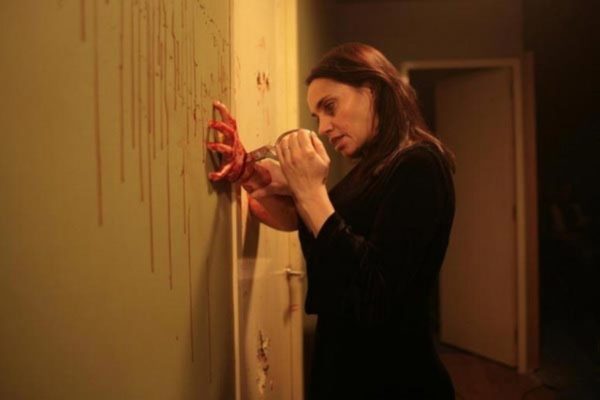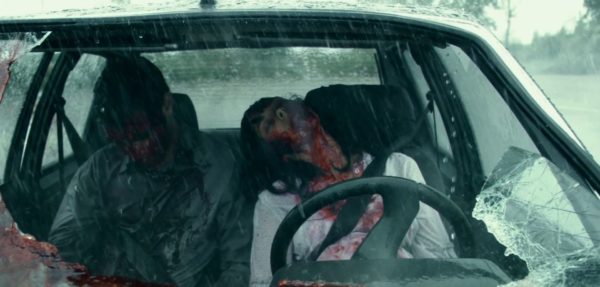
La Femme has no boundary issues in Inside
In He Said/She Said, critics Joe and Valeska dissect a film in a back and forth email exchange. Last time we hung out with bearded weirdo Mark Duplass in Creep. This time, we’re safely locked up awaiting a special delivery and avoiding sharp objects with Alexandre Bustillo and Julien Maury’s 2007 French Extremity, Inside / A L’interieur.
Let’s bitch it out…
https://www.youtube.com/watch?v=5FKVN4JxvlE
Synopsis: Four months after the death of her husband Sarah (Alysson Paradis), a woman on the brink of motherhood, is tormented in her home by a strange woman – La Femme (Béatrice Dalle) – who wants her unborn baby.
HE SAID
I’ll admit that I had some trepidation selecting Inside. I first saw this film ten years ago when it came out on DVD (remember those?). I watched it alone in my house with a glass of wine and over the course of the film, I was so anxious that I wound up consuming the entire bottle and I had to keep my feet off the floor for fear of scissors in the dark. Inside remains one of my most visceral horror film experiences of all time, so I was worried that my nostalgia was inflating how good the film is.
I’m pleased to announce that a decade later, Inside (mostly) holds up. It’s a touch too long and some of the stuff with the cops at the end doesn’t really work for me, but overall this is a taut, tense watch and the extremely graphic gore remains as upsetting and wince-inducing as ever.
What stuck out to me watching this film a second time is how carefully laid out several plot elements are. I vaguely remember appreciating the callbacks, but I didn’t realize how integral events from the start of the film are until later. There is some obvious stuff like Sarah’s knitting needles (vital to both her and La Femme) and the moment we see Sarah’s eye through the hole in her knitting (foreshadowing several showdowns through the bathroom door). There’s also her use of the camera flash to get a better look at La Femme during the initial appearance at the window and the promised return of the cops and Jean-Pierre (François-Régis Marchasson) later that night.
Nearly the entire first act of the film lays out the groundwork for the remainder of the film. It’s pretty impressive considering that this is a mostly threadbare plot: mystery woman attacks pregnant woman over the course of the night. The end.
V, what caught your eye on this initial watch? Any visuals, costumes or sequences stand out to you?

SHE SAID
I’ll admit that I had some trepidation when you selected it — prior to this piece, I’d only seen the first twenty minutes, but the film’s reputation as being uncompromisingly brutal precedes it.
It turns out that its reputation is WELL earned.
Finishing the film has been on my To Do list for a while and I’m glad that I watched it. I don’t know that I’m in a rush to see it again soon — like you, I had an extremely visceral experience watching it. An experience that I enjoyed, some of the time. An experience that I appreciated, much of the time. And an experience that I only half-experienced (because I was curled up in a semi-fetal position with my eyes averted and my hands flailing) a lot of the time.
Funny that you should mention costuming, because that’s something that I was going to bring up. The dress that Béatrice Dalle wears as Le Femme is long, black, severe … and rather witchy looking. Perhaps I’m primed for this reference because of the work I’ve been doing on the witchcraft themed issue of Grim magazine, but one thing that really caught my attention was the folkloric elements of the story. A strange woman comes at night to steal a baby to make up for one that was “stolen” from her? That feels like a pretty classic foundation for a folktale about witches, and I appreciated the way that the costuming works to reinforce it. The contrast between the two women — Dalle in black, Paradis in white — also plays on a good/evil dichotomy which is common to folktales. Non-Disneyfied folktales often had bloody, unhappy endings, so I’m glad that Inside stays true to that tradition.
I’ll need to watch it again at some point to really catch all of the callbacks — as I said, I spent much of the time actively trying to distract myself from what was happening onscreen!

HE SAID
The witch/folklore observation is very clever. I hadn’t even thought of that. There’s actually a lot of coding – both hidden and explicit – in the film. I can’t do it justice here, but Inside has a whole commentary on class and racism hidden in those comments about the car fires and Sarah’s mother’s concerns about her safety (For more on the new French Extremity movement and how it reflects events in France in the 2000s, be sure to check out The Faculty of Horror’s Alexandra West’s book, Films of the New French Extremity: Visceral Horror and National Identity).
One other element that I’ve always fixated on is Inside’s intriguing deconstruction of maternal love. On the first viewing, I took things as presented, assuming that like all Final Girls, Sarah was fighting back against her accuser to save the life of her unborn child (glimpsed in utero for maximum audience manipulation, albeit in less than stellar CGI).
On my second watch, however, it is exceedingly evident that Sarah is not very happy in her pregnancy. Obviously the scene in the park when she takes pictures of a family with two parents suggests that she’s struggling with her grief for her dead husband, but throughout the first act Sarah also seems mildly resentful of her offspring. The ultimate subversive moment occurs in the third act: Sarah has been severely beaten by La Femme and in the moment when all hope appears to be lost, she turns the knitting needle on her child. When push comes to shove, Sarah is willing to sacrifice the baby’s life to save her own. It is such a striking moment because it dares to fly in the face of the Hollywood tropes that decree a mother lay down her life for her offspring.
There’s a similar inversion of tropes during the horrifying emergency caesarean (with SO.MUCH.BLOOD) on the stairs. It plays on our expectations that La Femme will help Sarah because she and the baby are in danger. Of course, this makes no sense considering what we’ve seen for the past 85 minutes, and yet both times I’ve watched Inside, I mistakenly believe that La Femme is no longer a malevolent threat. And that’s just not the case; in reality, she’s simply cutting her way to victory.
Both Sarah’s lack of maternal spirit and La Femme’s disinterest in helping Sarah once she has what she wants are moments that play on the (false) socially constructed beliefs that women are maternal to children and pregnant women. Inside isn’t simply memorable because of its insane gore and tension; for me, it’s the residual darkness of those final shots. The slow pan across the mother who would sacrifice her child, dead on the stairs, and the slow push on the woman with no care for human life, bathed in blood and red lighting, holding her prize. It’s so damn grim. A strong 9/10 for me.
V, part of the reason we decided to screen Inside is because the long-delayed US remake is debuting on VOD today. What do you think the new version will offer and do you think it’ll have even a fraction of the gore, tension and twisted morality of the original?
SHE SAID
I certainly hope so, but I think that in the US it is a lot less socially acceptable to acknowledge an ambivalence (much less a resentment) towards motherhood. While it may measure up in terms of blood, tension, and gore, I worry that the remake may lose some of the original’s nuance when it comes to that element of the storyline that you so eloquently outlined above. My guess is that the subtle cues regarding Sarah’s state of mind will be jettisoned — perhaps, instead, we’ll get a scene of her excitedly painting a nursery.
I could be wrong (and I hope that I am) because I think that we need films and stories that illustrate the diverse and complicated feelings that women can – and do – have towards maternity. So often, when a woman expresses a lack of interest in bearing children, she is painted as selfish or immature. I think it’s time that stories began exploring the different meanings that motherhood has for different people. If we do see that in the American version, I’ll be pleased…but I’m not holding my breath.
My rating? 7.5 out of 10.
Next time: Joe and Valeska dive into the Lament Configuration for Hellraiser: Judgment shortly after it’s February 13 VOD release.
https://www.youtube.com/watch?v=a8EKwrYHegw
Want more snark and criticism?
- Follow Valeska @bitchcraftTO and check out her kickass female-run, queer-positive horror and lifestyle site Anatomy of a Scream
- Follow Joe @bstolemyremote and be sure to join the Bstolemyremote FB group for daily TV and film updates